Thunder Down Under
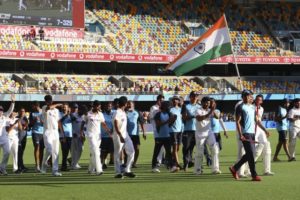 A tired-looking Josh Hazlewood hustled in for one last hurrah. The wicket of Shardul Thakur a couple of balls earlier had given Australia a slight ray of hope. They needed a miracle though. A low full toss it was outside the off-stump. Pant had been at the crease long enough to eye the ball with ease and drive it through the vacant mid-on region and as the ball tickled to the boundary, I and Neel jumped in ecstasy. The Gabba was breached after 32 years. History was created as India chased down 328 runs to bring to a close an epic turnaround which will go down as the best test series ever played by India on foreign soil. It was epic and it was heart-stopping. It was an unimaginable feat something that would have been last in any Indian cricket fan’s mind after watching the team getting bowled out for 36 runs exactly a month back.
A tired-looking Josh Hazlewood hustled in for one last hurrah. The wicket of Shardul Thakur a couple of balls earlier had given Australia a slight ray of hope. They needed a miracle though. A low full toss it was outside the off-stump. Pant had been at the crease long enough to eye the ball with ease and drive it through the vacant mid-on region and as the ball tickled to the boundary, I and Neel jumped in ecstasy. The Gabba was breached after 32 years. History was created as India chased down 328 runs to bring to a close an epic turnaround which will go down as the best test series ever played by India on foreign soil. It was epic and it was heart-stopping. It was an unimaginable feat something that would have been last in any Indian cricket fan’s mind after watching the team getting bowled out for 36 runs exactly a month back.
From the depths of despair rose this team of absolute no-hopers whom I called the Hospital XI before the start of the Final Test Match to script the biggest turnaround in cricketing history and in the process gave us the best cricket series ever on Australian soil.
It was a snowy morning in Srinagar on 5th January 2019. I was on my way to the airport and the roads, the buildings all were covered with a thick blanket of snow due to the overnight snowfall. We had been in Kashmir for the last 8 days and though we experienced snowfall on our way to Sonmarg on 2nd January, it was completely dry in Srinagar. But on 4th January while on our way to Shankaracharya Temple, it started to snow and by the time we were back from the temple the entire area turned white. It was an experience of a lifetime no doubt but we had a flight to catch the next day and after a certain time, we sincerely hoped for the snow to stop.
“Man proposes but God disposes”
As destiny would have it, the snowfall continued right through the night. By the time we reached the airport, the snowfall had subsided but all flights were canceled. The next available flight was on 9th January for Kolkata and suddenly we had 4 extra days to spend in Srinagar. We had loved the place no doubt but we needed to go home, more so for me and Asif because Asif’s sister-in-law was battling the last stages of cancer and my father was battling kidney failure and had to be hospitalised on that very day with me, not in town.
The situation was serious back home and we harboured thoughts of taking the road route to Chandigarh but we came to know that the Jammu-Srinagar highway was blocked due to heavy snow and with no options left, we had to go back in town and found a hotel nearby for those additional 4 days of stay over. Over the phone, I kept in touch with family and more so with Mukesh who had to take additional pressure of taking my father to the hospital and to do the needful. The only way to keep ourselves engaged was the cricket match that was going on in Sydney.
When we started for the airport, Australia began their first innings after a mammoth total put up by India. India had scored 622 runs before they declared late on the second day. Chetaswar Pujara and Rishabh Pant both scored big hundreds to set up the match for India. India was on the cusp of creating history because a draw or a win in Sydney would see them winning a Test series in Australia for the very first time. By the time we checked in to our hotel, the day’s play was over – rather, cut short due to bad weather. Australia was at 236/6 and India had a good chance to win the Test Match with 2 days to play. The only problem for India was the weather because it was expected to rain over the next two days in Sydney.
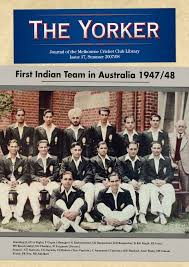 India first went on an Australian tour as a young independent nation in 1947. That team led by Lala Amarnath lost 4-0. India over the years has gone on multiple tours down under but my journey as a fan watching cricket down under began from the 1991-92 series. Getting up early in the morning was a challenge but cricket mattered more than the chilly mornings of Asansol. Over the years it became a ritual whenever the Indians traveled to Australia the frequency of which has noticeably increased over the past few years.
India first went on an Australian tour as a young independent nation in 1947. That team led by Lala Amarnath lost 4-0. India over the years has gone on multiple tours down under but my journey as a fan watching cricket down under began from the 1991-92 series. Getting up early in the morning was a challenge but cricket mattered more than the chilly mornings of Asansol. Over the years it became a ritual whenever the Indians traveled to Australia the frequency of which has noticeably increased over the past few years.
After the 1991-92 tour, India next toured Australia in 1999-2000 – a gap of 7 years and now we have the team visiting Australia every 2 to 4 years. I might have grown up but cricket takes me back to childhood and the mannerisms while watching cricket have not changed. My wife calls me childish when she sees me react the way I do when things don’t go India’s way but then you need to love cricket to understand the emotions that a fan goes through while watching India play.
The 4th day in Sydney on 6th January 2019 was partly disrupted due to rain. We had no work and nor we had the mindset to roam around Srinagar with the problems at hand back home and the only way to keep the mind away from those troubles was to watch cricket. Unfortunately, the first session was washed off and with each passing hour, India’s chances of winning the match eroded. It was not a problem though because India was already ahead 2-1 in the series. Play resumed post-lunch and India got the Australian team bowled out for 300 runs and enforced the follow on. Unfortunately, not much play was possible thereafter with the next 4 sessions being washed out as we 3 sat and kept watching the highlights of the wins registered by India at Adelaide and Melbourne.
 In wet conditions in Sydney on 7th January 2019, the Border-Gavaskar trophy was handed over to India and thus ended India’s 71 years wait of winning a Test Series in Australia. It felt like a personal victory that day because as a fan, I had been diligently waking up at 5 AM from 1991 whenever India played Australia down under, and finally, all those early wake-up calls bore fruit as the jinx was finally broken. Yes, India had won some great Test Matches in Australia be it the 2003 win in Adelaide or the 2008 win in Perth but none of those wins led us to a series victory. So this was extra sweet because for the first time after 1977 that India won 2 matches in a series in Australia but unlike then, this time the Indian team came out trumps by winning the series on Australian soil. History was created and it felt great to have seen it happening right in front of our eyes. It was bittersweet for me though because my father who used to diligently wake me up early in the mornings in 1991 was not there with me right at that moment as he laid in the hospital bed, back in Kolkata. I remember spending multiple hours speaking with him and debating India’s performances down under over the years and before I left for Srinagar, both of us felt that there was an opportunity for India to break the jinx this time around. I waited with bated breath to get back to Kolkata and get him back safe at home so that we both could savour this victory which we so yearned for over the last 3 decades.
In wet conditions in Sydney on 7th January 2019, the Border-Gavaskar trophy was handed over to India and thus ended India’s 71 years wait of winning a Test Series in Australia. It felt like a personal victory that day because as a fan, I had been diligently waking up at 5 AM from 1991 whenever India played Australia down under, and finally, all those early wake-up calls bore fruit as the jinx was finally broken. Yes, India had won some great Test Matches in Australia be it the 2003 win in Adelaide or the 2008 win in Perth but none of those wins led us to a series victory. So this was extra sweet because for the first time after 1977 that India won 2 matches in a series in Australia but unlike then, this time the Indian team came out trumps by winning the series on Australian soil. History was created and it felt great to have seen it happening right in front of our eyes. It was bittersweet for me though because my father who used to diligently wake me up early in the mornings in 1991 was not there with me right at that moment as he laid in the hospital bed, back in Kolkata. I remember spending multiple hours speaking with him and debating India’s performances down under over the years and before I left for Srinagar, both of us felt that there was an opportunity for India to break the jinx this time around. I waited with bated breath to get back to Kolkata and get him back safe at home so that we both could savour this victory which we so yearned for over the last 3 decades.
That series win in 2018-19 didn’t stop the critics though because they quickly pointed out that Australia was without the services of their 2 best batsmen, Steve Smith and David Warner (both serving a one-year ban after the Sand-Paper Gate scandal). It was not India’s problem but critics were critics and they quickly forgot that the bowling attack of Australia was world-class and forgot to give due credit to the Indian batsmen who scored runs consistently throughout the series. I remember many cricket experts waiting for the next series down under because they felt that the Indian team was at an advantage playing against a relatively weaker Australian side who were without Smith and Warner.
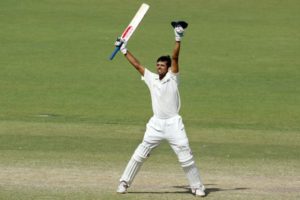 From the time I had been following cricket religiously, India had won only 2 Test Matches in Australia. Both I remember quite distinctively, the one in Adelaide in 2003 which was India’s first victory in Australia after 22 years, and the next one in 2008 in Perth which followed the Monkey Gate scandal in Sydney. That victory in 2008, stopped Australia’s 16 Test Match winning spree, and once again it was India who stopped them from breaking their own world record. In 2003 Rahul Dravid’s stoic in the crease earned him the nickname, “The Wall”. In 2018-19, Chetaswar Pujara reenacted Rahul Dravid’s heroics and helped India win the series and people started calling him the new wall of India.
From the time I had been following cricket religiously, India had won only 2 Test Matches in Australia. Both I remember quite distinctively, the one in Adelaide in 2003 which was India’s first victory in Australia after 22 years, and the next one in 2008 in Perth which followed the Monkey Gate scandal in Sydney. That victory in 2008, stopped Australia’s 16 Test Match winning spree, and once again it was India who stopped them from breaking their own world record. In 2003 Rahul Dravid’s stoic in the crease earned him the nickname, “The Wall”. In 2018-19, Chetaswar Pujara reenacted Rahul Dravid’s heroics and helped India win the series and people started calling him the new wall of India.
India was scheduled to travel once again to Australia in 2020-21 but before that Covid-19 stuck and the pandemic led to worldwide lockdowns and cricket was the last thing on anyone’s mind. With European Championships, Olympics all getting postponed it was pretty difficult to see the marquee series happening on time. But then things started to get better as England started playing international cricket at home under Covid restrictions and then IPL happened in the middle east in late September. To successfully organise a tournament of such magnitude, gave confidence to people around the world and the series against Australia got the go-ahead. It was an important series too because India needed to make up for the lost points against New Zealand in the qualification run for the World Test Championships final.
India had problems though with the injury to Rohit Sharma during the IPL and to top that Virat Kohli was about to become a father and hence decided to take paternity leave and was not available to play after the first Test Match. India selected a few newcomers for the tour, like, Md. Siraj and Navdeep Saini. Not to forget Shubhman Gill who though have been part of previous touring parties, was yet to play Test cricket for India. Covid-19 restrictions meant that one couldn’t have the services of Australian first-class cricketers as net bowlers and hence players like, Kartik Tyagi and Natarajan went along with the team. Natarajan of course was a last-minute replacement for Kamlesh Nagarkoti who pulled up injured during the IPL. As luck would have it, Varun Chakravarthy (who was originally selected for the T20 team) pulled up with a shoulder injury before the team was scheduled to leave for Sydney, and Natarajan was officially made a part of the team for the ODI and T20 series.
To be quite frank, the team looked weak on paper more so because of Rohit Sharma’s unavailability and Virat Kohli’s absence after the 1st Test. Add to that there was no Ishant Sharma in the team who was nursing an injury. Australia was back at full strength with the availability of David Warner and Steve Smith. Smith in particular has over the years been a tormentor in chief for India having an enviable record with a batting average exceeding 60. Both these players along with the emergence of Marnus Labuchagne made the Australian team an almost invincible one, especially in home conditions. Their bowling attack was the same as in the 2018-19 series led by the world’s number one bowler, Pat Cummins. All in all, things looked exactly the opposite of the 2018-19 series with India missing some key players whereas Australia had the service of their first XI.
The ODI series started on expected lines with Australia winning the initial 2 matches. All the matches were high scoring ones but Australia won them with ease because they scored a mountain of runs batting first. Though India batted well to score more than 300 runs in each of the matches they were not good enough. At that stage people on Twitter were debating if this would be the worst tour for India in Australia with many comparing this side with the one in 1999-2000 when India couldn’t win a single match against the Aussies (both Tests and ODIs included). India though put that debate to rest by defeating Australia in the third ODI to get a consolation victory. What was great to see though was the debut of Natarajan and the slog over hitting by Pandya and Jadeja. It raised the hopes of the Indian fans at least for the T20 series which followed.
In the T20 series, India did the opposite of the ODI series by winning the first two matches and once again Natarajan impressed with his accurate lengths and lines and most importantly with his consistency in hitting the yorkers. Hardik Pandya, Ravindra Jadeja, and KL Rahul impressed the most as India won the series 2-1 and put to rest any doubts that the team would perform as badly as the one in 1999.
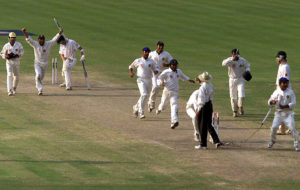 Test Matches was a completely different ball game though but one thing everyone discounted was the fighting spirit that the Indian team possessed. In a sense, it all started from the 2001 series against Australia in India when the greatest turnaround in cricket was played out at the Eden Gardens. That victory in 2001 stopped Australia’s world-record winning run in Test Cricket which included 16 straight Test Match victories. The fighting spirit and to never give up against all odds had been the hallmark that defined Team India from the time Sourav Ganguly took over the Indian captaincy. What was sown 2 decades back has now become a mantra for this team and no longer India were pushovers in foreign conditions. How ironic it was that the same man was now heading the BCCI and how satisfying it must be for the man as India scripted a turnaround for the ages in Brisbane 2021.
Test Matches was a completely different ball game though but one thing everyone discounted was the fighting spirit that the Indian team possessed. In a sense, it all started from the 2001 series against Australia in India when the greatest turnaround in cricket was played out at the Eden Gardens. That victory in 2001 stopped Australia’s world-record winning run in Test Cricket which included 16 straight Test Match victories. The fighting spirit and to never give up against all odds had been the hallmark that defined Team India from the time Sourav Ganguly took over the Indian captaincy. What was sown 2 decades back has now become a mantra for this team and no longer India were pushovers in foreign conditions. How ironic it was that the same man was now heading the BCCI and how satisfying it must be for the man as India scripted a turnaround for the ages in Brisbane 2021.
Doing well in white-ball cricket doesn’t always translate into having the upper hand in Test cricket. Test cricket is not about slam-bang cricket. It’s about patience and perseverance. Australia was a stronger team than the one India met two years ago. Steven Smith was back and though David Warner sat out due to injury they had Marnus Labuschagne whom many called the Steven Smith carbon copy because of the way he played. In 2018, it was in Adelaide that India started their victory journey and India was back at the same venue though this time it was played under lights – India’s first day-night test match down under.
Within the first hour of play, it was clear that it was a completely different ball game with India finishing the first session at 41/2. Before the start of the test series, it was a known fact that if India had to do well, then the Indian middle-order had to shine just like in 2018/19. But the Australian attack comprising of Pat Cummins, Mitchel Starc, Josh Hazlewood, and Nathan Lyon didn’t give any freebies and runs were extremely difficult to come by. Wickets fall like nine pins in the final session in day-night test matches, especially in Adelaide but Virat Kohli stuck in and brought up an excellent half-century. 2020 had been such a strange year that it was for the first time after 2008 that Kohli didn’t have an international hundred in a calendar year. He looked determined to end the year on a high because it was his final match before he traveled back to India. India seemed to be cruising at 188/3 when a moment of madness brought the Indian team crushing down. A bad call for a tight single led to the dismissal of Virat Kohli and India lost a wicket against the run of play. The lucky break for Australia did wonders for them as the next 6 wickets fell adding only 56 runs and with that handing over the momentum to Australia.
One thing that we have got used to over the past couple of years has been the resilience of this Indian cricket team. The never say die attitude meant India was never out of the game. Indian pace bowing resources have enhanced in the last few years and though Ishant Sharma and Bhubaneswar Kumar were not available the bowling attack led by Jasprit Bumrah was good enough to push Australia to the backfoot.
All the Indian bowlers were on top form when Australia came to bat and one could see that the batsmen were unable to break free. Unforced errors were committed and even with the lucky breaks given by India courtesy of the dropped catches, Australia found themselves reeling at 111/7. But test matches throw up surprises aplenty and when India was eyeing a lead of 100 runs or more, in came Tim Paine the Australian captain to play a captain’s knock to help Australia reach 191 runs. A lead of 53 runs was not bad but India needed to bat well in the second innings to drive home the advantage.
The fightback shown by the Indian bowlers of not allowing the Australians to take advantage of a low total put up by India deserved kudos because it was a good batting track but this Indian team was not ready to give an inch and found a way to wriggle out of tough situations. This was the New India after all – The young aspirational India who were not ready to be burdened by past historical mistakes. Gone were the days when Australian batsmen could pile on runs as the Indian team looked on haplessly. Ravichandran Ashwin was the star with 4 wickets and he answered his critics in style who before the start of the Test match commented that Ashwin got the opportunity to play only because of the disposition of Ravindra Jadeja.
India came out to bat in the second evening having a handful of overs to play but Prithvi Shaw failed once again and India finished at 9/1 at the end of day 2.
On our WhatsApp group where we discussed mainly cricket, the feeling was that India needed to bat most part of day 3 and a lead of around 300 would be good enough judging by the way the Indians bowled in the first innings. I was a bit late in switching on the TV the next day and when I switched it on, I saw the night watchman, Jasprit Bumrah was already back to the pavilion with the scoreboard reading 15/2. It was a Saturday and I hoped to enjoy a great day of batting by India but all my hopes were dashed as India plummeted into a hole and within a space of a couple of overs, India was reeling at 15/5. Each ball bowled looked like a wicket ball. And very soon, Virat Kohli also bit the dust and at 19/6, I had seen enough to switch off the TV and got back to reading a book. It was depressing, to say the least. There was a reason why this Australian bowling attack was touted as the best in the world and as one after the other Indian batsman walked back to the pavilion, I couldn’t imagine what was in store in the next 3 matches. The only academic interest left was would India be able to surpass 42 runs (which till then was the lowest total ever scored by India in a Test Innings). That of course didn’t happen as India was bowled out for 36 runs to register one of the lowest moments for India in Test cricket history. In the process, Md. Shami broke his arm and an already tough series looked even tougher with another frontline bowler set to miss out in the next 3 matches.
A Test Match lost inside 3 days when at the end of Day 2 India was ahead of Australia. One session of brilliant bowling changed the complexion of the match completely. With Virat Kohli leaving for India and Md. Shami not available, it looked like a mountain to climb for the team. The cricket experts across the globe followed the same tune and almost everyone predicted a 4-0 whitewash. Nobody could really blame them because when a team gets bowled out for 36 runs, it’s hardly expected of them to draw or win a test match.
As a cricket fan I was dumbstruck and in fact, didn’t speak about cricket for the next week. It was too difficult to digest that the team could get bowled out for 36 runs. Yes, Australia was a great team but the capitulation of the Indian batting line up was too hard to digest.
Old habits die hard though and there I was back in front of the TV on 26th December for the start of the boxing day test match at the MCG.
Md. Siraj got his debut test cap replacing, Md. Shami. Wridhiman Saha was dropped and he was replaced by Rishabh Pant and Ravindra Jadeja took the place of Virat Kohli. India also handed a debut to Shubhman Gill who replaced Prithvi Shaw. The team balance looked good and in effect, India replaced Virat Kohli by adding Pant and Jadeja. This also helped the bowling unit because the addition of Jadeja meant an extra hand for the team in the field. The very first hour showed that the Indian team had no hangovers of the Adelaide match as Australia was reduced to 38/3. The bowling unit once again was doing what was expected of them. Siraj looked nervous in his first spell but after lunch, he was able to put the ball in the right place and reaped rewards too by picking up the wickets of Marnus Labuschagne and Cameron Green. Jasprit Bumrah picked up 4 wickets as Australia was bowled out for 195 runs.
It was a good start for India in the Test Match no doubt but the 36 all-out was already playing at the back of my end when Shubhman Gill came out to bat with Mayank Agarwal to open the Indian innings. Mayank Agarwal got out to a swinging Mitchel Starc delivery in the very first over and my heart stopped beating for a while. “Oh No, Not Again”, I thought. Thankfully though Shubhman Gill looked good at the crease and he and Chetaswar Pujara took India to 38/1 at stumps on Day 1. After being absolutely hammered to submission on the third day at Adelaide this was a good fightback by India. No more demons in the head, I thought and I hoped that I will have a good Sunday seeing the Indian team bat on the second day at the MCG.
That’s how it played out and the Indian batsmen led by their new captain, Ajinkya Rahane wore down the Aussies to take the lead in the test match. Rahane played a captain’s knock hitting a century and was ably supported by others. Jadeja scored a half-century and India took a big lead of 131 runs. Indian bowling attack even without Ishant and Shami looked good and this time around, Umesh Yadav gave India the first breakthrough getting rid of Joe Burns. But then came the twist as Umesh Yadav pulled up with a calf injury and left the ground. In hindsight, it was good that India had 5 bowling resources and there was no shortage of armoury. Once again the Indian bowling attack delivered and at 99/6, India harboured hopes of inflicting an innings defeat on the Aussies. That would have been some statement coming after 36 all out but that didn’t happen as the Australian tail wagged for quite a long time and the last 4 wickets added 101 runs with Cameron Green top-scoring with 45 runs.
A confident India walked off the park with the team needing 70 runs for victory. Melbourne has been India’s happy hunting ground in Australia having won 3 test matches (the highest number of matches won by India in any venue in Australia) and it looked like India was on their way to win the 4th one. There was tension in some of my WhatsApp groups when Mayank and Pujara fell in quick succession (36 all-out still playing on our minds) but Rahane along with Shubhman Gill played positively and took India to a famous victory.
It was a great Test victory for India mainly because of the way the team fought back after the Adelaide fiasco. People wrote this team off but they came back with heads held high to defeat a very strong Australian side within 4 days. In the process, they lost another frontline bowler but the way the team showed resilience after Adelaide, nothing could stop them.
2020 was a year of pain as many around the world lost their near and dear ones. The victory registered by the Indian team on 29th December 2020 brought back smiles to millions of cricket fans in India who had been through many hardships over the last 9 months. It also meant that the series was now even stevens and no longer the Aussies could take the Indian team for granted.
The next Test match was to be played in Sydney from 7th January 2021 – the day 2 years back when India won their first Test series in Australia. With the 4th and the final match to be held in Brisbane, it was vital for India to try and keep the momentum going in Sydney because Brisbane was a virtual fortress for the Australian team where they have remained undefeated for 32 years.
Rohit Sharma finished his mandatory 14 days quarantine to join the team which meant, Mayank Agarwal, missing out on the playing XI. With Umesh Yadav also out with injury, Navdeep Saini became the latest debutant to play for India. 2 virtual newcomers in the bowling line up and suddenly the Indian bowling attack looked vulnerable.
Sydney as expected was a good batting track and Australia made good advantage of winning the toss and batting first. At 206/2, it looked ominous for India but as has been the story of the series, India fought back strongly and was able to restrict Australia to 338 runs. Steven Smith was having a horrible run in the last 2 matches but he came back to form scoring a beautiful hundred. Jadeja showed the importance of his selection by picking up 4 wickets and executing a marvelous run out to get Smith out which brought the Australian innings to a close. After the defeat in Melbourne, Australia was expected to come back hard and they needed Steve Smith to come to the party. He didn’t let the team down and for the first time in the series, the Australian batting unit was able to overcome the Indian bowling attack. It was still not a very bad performance by the Indian bowlers because Australia had a good opportunity to bat India out of the Test match.
I was excited to see how Rohit Sharma performs as an opener in foreign conditions. For a long time, Rohit Sharma has been an enigma in Indian cricket. His performance in white-ball cricket never replicated when playing Test Matches and though he got a new lease of life when the team got him as an opener in Test matches, he was yet to play as an opener outside India. So it was a new challenge for him and it was important for India too that he along with Gill gave India a solid start.
India started well with the openers putting on a 70 run stand but thereafter things didn’t go according to plan as the Australian bowlers kept picking up wickets at regular intervals. Shubhman Gill and Chetaswar Pujara scored half-centuries but no one was able to play a long innings and India folded for 244 runs.
A lead of 96 runs was pretty big and Australia pressed on the paddle to bat India out of the Test Match. If this was not bad enough, news filtered in that Ravindra Jadeja had dislocated his thumb while batting having been hit by a rising delivery. Another Test Match and another player down for India. It was that kind of a series for India wherein the team kept losing a player or two after a match. The bowling resources were highly depleted and Labuschagne and Smith took full advantage of the situation to build a big partnership. Australia kept batting till Tea on Day 4 and declared at 312 runs giving India a target of 407 runs to win the match.
Once again the Indian openers gave India a great start stitching a 71 runs partnership but both Gill and Rohit got out before the end of Day 4. India finished at 98/2 when stumps were drawn.
309 runs to get on the last day was not out of reach for India but with 2 wickets down, survival was the best way to go forward. 98 overs India had to survive and against the bowling attack of Australia and at the outset, it looked like a herculean task. India didn’t start well as Rahane got out in the second over of the morning. India’s mindset was positive though because in place of sending Hanuma Vihari they gave a promotion to Rishabh Pant. Pant had been injured while batting in the first innings and to see him come out to bat made me sit up.
Rishabh Pant has been countless times criticised for the way he played mainly due to the reckless shots that led to his downfalls. But such players have another angle too and that was if they came good, you will have to sit up and watch. As Pujara played the waiting game and brought all his experience in play to hold one end up, Pant kept attacking the bowlers. On a 5th day pitch in Sydney, it was expected that Nathan Lyon would be the tormentor in chief but Rishabh Pant hit him out of the park more than once and got him out of the attack. Batting at close to run a ball, India suddenly harboured hopes of winning the match. Suddenly Australia was on the backfoot with spread-out fields. 108 runs in the first session gave high hopes to India and another session of such high-quality cricket and who knows, maybe India could pull this off, I thought.
Rishabh Pant plays with a similar mindset of Virendra Sehwag. If a ball was there to be hit, he would go for it even if it meant taking on the boundary riders.
“Live by the sword, die by the sword” – On 97 with a century for the taking, Pant gave Lyon the charge only to miscue the hit and got caught.
With Pant’s wicket India’s chances of going for victory diminished especially because Jadeja had a broken finger and there was no other player who could play the positive brand of cricket that was needed to take India to victory. What was even worse for India was that Pant got out in the 80th over which meant a new batsman had to face the new ball.
Hazlewood snared the wicket of Pujara with the second new ball and as Ashwin walked into the crease to join Hanuma Vihari India still needed to play out 44 overs. The victory was still 127 runs away but at that time it was all about survival. With Jadeja not in a condition to bat, it was effectively India’s last recognised batting pair who had to take India to safety.
In the meanwhile, as luck would have it, Hanuma Vihari got injured. From the outside, it looked like a hamstring strain which meant he was hardly able to walk and his leg movement was very limited. It was now a fight of determination because there were only 2 possible scenarios – Australian victory or a draw. India quite understandably opted for the second but to survive for so long against such an attack looked impossible. The Aussies kept peppering short balls and Ravichandran Ashwin kept taking hits on his body.
People play for victory but in this case, for India, a draw was as good as a victory. As overs passed by Ashwin gained confidence. Here was a player with 4 Test hundreds behind him and he brought in all his experience and put his body on the line and ensured that he remained unbeaten. As time went on, the Aussies started getting frustrated and the ugly head of sledging raised its head. The Australian captain behind the stumps was the biggest culprit in this activity as he kept going after Ashwin with his non-sensical comments. Ashwin was well set by that time and no way was he to be fallible after coming so far. Tim Paine in the process of disturbing Ashwin, lost concentration himself and ended up missing a couple of catches. “Australia gave up all their luck in Adelaide”, I thought and it was high time that India got their due. With so many frontline players not available, India needed some divine help after all.
43 overs of resistance by Ashwin and Vihari finally brought fruit as India came back with an honourable draw. The draw was as good as a victory for India because, with 5 wickets down, Australia had all the ammunition to bowl India out more so with India’s premier all-rounder indisposed. But that was not to be as India came out of Sydney with honours even. It was a case of exemplary courage and perseverance shown by Vihari and Ashwin that evening in Sydney. Their performance defied all odds because Vihari was virtually batting on only one leg. But this was new India. The days of getting intimidated by Australia was over.
Right through the first two sessions of play on the last day whenever the camera hovered over the Indian dressing room, one could see, Ashwin standing. Little did we know at that time that he was suffering from terrible back pain which didn’t allow him to sit. After the match got over, Ashwin’s wife tweeted about the sufferings related to his back pain which didn’t allow him to tie his shoelaces by himself. As I said earlier, it was a magnificent show of courage by both him and Vihari because though both of them were in severe pain they didn’t let go of the job in hand. Vihari didn’t have a great series till then and 50 years later when someone goes through the score sheet they might not realise the value of these innings but people like us who saw the fight will remember forever.
It was a test match which was all Australia but it was India who was talked about most because of the fight showed by them on the last day. It was a classical rearguard action and for a change, it was Australia who came back with “what ifs” on their mind.
It all finally came down to the “Gabbatoir” to break the deadlock – a venue where India never won and where Australia never lost after 1988.
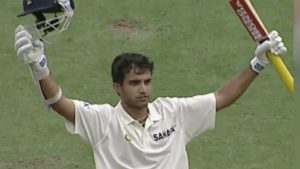 For India, a draw was enough for them to retain the Border-Gavaskar trophy but it was a venue where India’s best result was a draw in 2003. India had played in Gabba 6 times previously losing five of those and with a team that quite literally looked like a hospital XI, all odds favoured Australia.
For India, a draw was enough for them to retain the Border-Gavaskar trophy but it was a venue where India’s best result was a draw in 2003. India had played in Gabba 6 times previously losing five of those and with a team that quite literally looked like a hospital XI, all odds favoured Australia.
Before the start of the last Test Match what was interesting to see was who would turn up for India. With so many players injured there was hardly any choice left for the team management. After the match at Sydney, Jadeja was ruled out with his finger getting fractured. Add to that Hanuma Vihari was also out of contention with a hamstring tear. Jasprit Bumrah was having an abdominal strain and Ashwin was down with his lower back issues which meant both of them were not 100% fit. With the England series coming up it was not advisable to risk aggravating the injuries. But then who would play? Jokes started floating around on WhatsApp and Twitter that we might see Ravi Shastri back in whites. Jokes apart, it was a serious problem for India and it was hardly something which they wanted to do, going in Brisbane which by itself was a fortress yet to be breached in 32 years. But then life is all about how best you do with the resources you have in hand. On one hand, the tried and tested players were nursing injuries and on the other hand, new opportunities were about to open up for some talented youngsters.
It was 15th January and with a cup of tea in hand, I turned on the TV to watch the match unfold. India came up with a surprise by going in with 4 fast bowlers and a lone spinner in Washington Sundar. Two new debutants once again for India and this time it was Washington Sundar and T. Natarajan. Both of them came to Australia as part of the team for the white ball series and then stayed back as net bowlers. Graduating from net bowlers to test match cricket within a couple of months was unprecedented but desperate times called for desperate measures. Shardul Thakur was also selected and though it was not his debut match, one could consider it to be one because the one test match that he played two years back against the West Indies was just for the record books since he got injured after bowling 10 balls. Md. Siraj, an experience of 2 Test matches was about to lead the bowling attack that possessed a collective experience of 4 test matches. This was the most inexperienced Indian bowling lineup in 50 years and on paper, it looked like a third rung bowling attack. Comparing with Australia, on paper it looked like game, set and match for the Aussies.
India’s bowlers started well and after the first hour, it was tough to believe that Australia was struggling against such an inexperienced pace attack. But as the day wore on, Australia went from strength to strength with Marnus Labuschagne hitting a century. Against the run of play, Natarajan picked up 2 wickets which included the wicket of the centurian, and once again, India fought back into the match. Australia though took the day’s honours at 274/5.
I have seen better Indian attacks being taken for 400 runs in a day in Australia and to compare that performance one could easily say that India didn’t do too badly. It was a known fact that the bowling attack would struggle but the good thing was that India didn’t let the Aussies roll them over.
India needed to make use of the new ball on the second morning and that’s what India did by picking up 3 quick wickets. The Australian tail wagged for a while before the team was bowled out for 369 runs. If anyone would have asked who was the happier camp then quite easily it was India because keeping Australia under 400 runs was a very good achievement. The newcomers did excellently well with Sundar, Natarajan, and Thakur picking up 3 wickets apiece.
India needed to bat well though because batting last at the Gabba was not supposed to be easy. In Test cricket when a batsman gets his eye in, it’s important for them to put up a big score. This is exactly where the Indian top order failed with 5 of the top 6 batsmen getting past the 20 run mark but no one went on to get a big score and once again India found themselves on the rocks at 186/6.
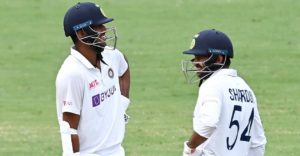 Throughout the series whenever the chips have been down, someone from the Indian team had raised their hand and came up with an exemplary performance. And as if on cue when the situation looked absolutely grim, out came the partnership of the match between, Shardul Thakur and Washington Sundar. Both the players were no mug with the bat but to see them playing so confidently against the Aussies in Australia was scantly believable. But then this was a team that was not ready to throw in the towel at any point in time and the partnership of 123 runs ensured that India reaches close to the Australian total. When India’s score went past the 300 run mark, for a brief while I felt India might as well go past the Australian total. That was not to be though because once Shardul Thakur got out, the rest of the tail didn’t wag long enough and India finished at 336 runs with Hazlewood picking up 5 wickets.
Throughout the series whenever the chips have been down, someone from the Indian team had raised their hand and came up with an exemplary performance. And as if on cue when the situation looked absolutely grim, out came the partnership of the match between, Shardul Thakur and Washington Sundar. Both the players were no mug with the bat but to see them playing so confidently against the Aussies in Australia was scantly believable. But then this was a team that was not ready to throw in the towel at any point in time and the partnership of 123 runs ensured that India reaches close to the Australian total. When India’s score went past the 300 run mark, for a brief while I felt India might as well go past the Australian total. That was not to be though because once Shardul Thakur got out, the rest of the tail didn’t wag long enough and India finished at 336 runs with Hazlewood picking up 5 wickets.
A 33 run lead was not something Australia bargained for having India at 186/6 but then that is what makes cricket the game it is.
As someone aptly posted on Twitter, “between 36 and 336 we all grew up”. Cricket for people like us is a way of getting back to our childhood days and I feel sorry for people who do not follow this wonderful game. Nothing beats cricket and more so Test cricket.
Back in 2003, Australia led by 33 runs before a spell by Ajit Agarkar shifted the momentum towards India which helped them defeat the Aussies in Australia for the first time in 22 years. The lead was 33 runs again – will history repeat itself? I wondered. But then, it was Gabba, a place where Australia has remained undefeated for 32 long years. But, as my good friend, Asif said, records are meant to be broken so anything could happen and India could very well win the match.
The onus was now completely on Australia to force the game because they needed to win to regain the Border-Gavaskar trophy. It by no way means that India played negatively but an inexperienced bowling attack was under pressure as Warner, Labuschagne, and Smith went after the Indian bowlers. Aggressive cricket leads to wickets too and India kept picking up wickets at regular intervals and in a little over 2 sessions Australia was bowled out for 294 runs. To bowl out Australia twice with a collective experience of 4 Test matches was unbelievable, to say the least, and this Indian team made all of us proud with their gallant display.
328 runs to win for India with 3 and a half sessions to play. The game was in the balance when the rain started falling making the predictions of late evening rains on the 4th and 5th day come true.
The evening was spent discussing India’s would be strategy for the fifth day. One of my friends, Sabyasachi Das was interested to know the weather predictions too though Asif wanted the day to be dry because he was confident of an Indian win.
It had been exactly 30 days since India was bowled out for 36 runs in Adelaide and to think that the series was still on the line with a day to play was an achievement by itself by this injury-ridden team. As my friend Asif told me that taking 20 Australian wickets with this inexperienced bowling lineup was a story in itself. Undoubtedly he was right because at no point did this beleaguered team allowed the opposition to intimidate them. Yes, it was a tough chase but going by the temperament shown by the team after the Adelaide fiasco anything was possible.
In Sydney, India needed 309 runs on the last day with 8 wickets in hand.
At Gabba, India needed 324 runs with all their wickets intact. If they could save Sydney why couldn’t they repeat it or better it at Brisbane?
Cricket is a game of glorious uncertainties and hence a favourable result for India was definitely possible though a last-day pitch with a crack right through the middle of the wicket was a challenge facing the Indian team.
Final day chases are not like white-ball cricket. The first session is always about survival and about not letting the opposition get wickets with the new ball. The second and final sessions are when the fun of the chase begins. But the fun could only start if the team chasing had enough wickets in hand.
By all calculations, India also planned in the same manner. The advantage for India was that with Rohit and Gill they had two very good openers who could play the waiting game as well as play aggressive strokes. India needed a solid start but Rohit got out cheaply. As Pujara walked in, I yearned for one more cup of tea but the superstition had kicked in by then and I was not ready to leave the place till the drinks break at least.
Pujara played like the way only he can. His strategy was about wearing down the bowlers and holding one end up as Gill played his natural game.
One and a half hours into the day with the sun beating down the Aussies changed their strategy. In came the barrage of short balls. You can’t call them body line but it was an attack on the body through short pitch bowling. It was a worn down pitch and with some balls not rising high enough, India entered a zone of intimidation from the Aussies. This is what they do best – intimidating the opposition. Pujara got hit on the helmet twice and on the shoulder a few more times but he didn’t bat an eyelid. My son sitting beside me kept asking me how was Pujara not showing any emotions when getting hit? I told him that’s how it is. You can’t show that you are feeling the pain. You should remain expressionless under adversity because your opponent gets frustrated when even after intimidation you don’t show any emotion or pain.
What was important during that passage of play for India was that they didn’t lose wickets. Gill on the other side was playing his natural game. Short balls were pulled and fuller balls were sweetly driven on the offside. His backfoot punches were soothing to the eye. As I saw him bat I just hoped for a big partnership between him and Kohli soon because it would be such a treat to watch.
Lunch was taken with India at 83/1. Losing only one wicket in the first session was a very good result for India. As Shane Warne said on commentary India would back themselves to get 140 odd in the final session so this was an advantage for India going into the lunch break.
Still, a lot of cricket was to be played but for now, it looked like India would hold on to the Border-Gavaskar trophy.
Right after lunch, one could see a change in batting stance from Gill. A little opened up stance with the back leg going further across waiting for the short delivery. No trigger movement of the front foot which meant that India knew the line of attack that the Aussies would come up with. As expected Starc started bowling short but this time around he was met with fire as Gill hit him for a sixer and two fours to make clear India’s intentions. If that was not enough, Gill’s aggression rubbed on to Pujara too as he also played a couple of glorious cut shots. Mitchell Starc was promptly taken out of the attack.
But disaster struck straight after and the bowling change did the trick as Nathan Lyon snared the wicket of a well-set Shubhman Gill. At 91 runs he was all set for his maiden century but a moment of misjudgment led to his downfall. It was a very good hand played by Gill but for now, it was over to Pujara and Rahane to take India forward.
New age India has new-age fans and my son was a bit distraught seeing Rahane coming in at the fall of Gill’s wicket. He was of the opinion that aggression at one end and holding up the other end was the best way to go forward and so he felt Pant should have walked in ahead of Rahane.
Though the name was different the strategy was exactly the same he had predicted and Rahane started off playing aggressively. A lofted six off Lyon made his intentions clear but this was not his natural game and trying to upper-cut a rising delivery from Pat Cummins brought about his downfall and India was three down with 167 on the board with close to half an hour to go for tea.
It was heading towards a classic finish because Australia you felt was just a couple of wickets away from claiming ascendency and India needed a solid hour or so batting from Pant to push the Australians into the defensive.
As a fan, I had followed the 1986 tied test match and this game was getting close to that because it was difficult to pick the winner with a session to play.
After tea, the most important segment of play was the new ball and Australians were eagerly waiting for the 80 overs to complete. In the meantime, Rishabh Pant brought out those outrageous strokes once in a while nothing better than the six against Lyon over long-on – dancing down the track and playing against the turn. What made it even more outrageous was that just a ball before, he was handsomely beaten by a similar delivery which hit the crack and turned and jumped awkwardly beating everyone. But then this was Rishabh Pant. He won’t allow the opposition to take centre stage. As long as he was in the crease it had to be all about him. During the IPL, Ricky Ponting the head coach of the Delhi Daredevils felt that Rishabh was an all-format player and was destined to display a lot of heroics in the future. Little he would have realised that the diminutive keeper was planning an encore at the Australian fortress.
The new ball though did it’s trick and Cheteshwar Pujara got out to a seaming in cutting delivery from Pat Cummins. Throughout the series, Cummins showed why he was the number one bowler in the world. As soon as we thought, India was cruising, out came Pat Cummins and he invariably picked up a wicket.
Pujara’s wicket was a blow to India because he played his role to perfection till then. He kept one end up and all the while kept getting hit on his body. On the last count, a total of 11 deliveries hit him on his body through the innings during the course of which he scored his slowest half-century. He played 200 balls and it was his resilience that allowed the others to play aggressively.
Mayank Agarwal had been in wretched form throughout the series. One advantage of having an opener coming down the order was that playing the new ball came naturally to him. But when a man is not in form you find ways to get out. And after playing a couple of lovely straight drives, he tried a lofted cover drive only to find the fielder and India was 5 down with close to an hour’s play still to go.
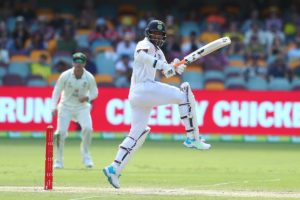 Washington Sundar in the first innings showed that he was a genuine all-rounder and his partnership with Rishabh Pant was a very vital one for India. Sundar played aggressively but the shot that stood out was his Nataraja style hook shot against Cummins which sailed for a six over deep square leg.
Washington Sundar in the first innings showed that he was a genuine all-rounder and his partnership with Rishabh Pant was a very vital one for India. Sundar played aggressively but the shot that stood out was his Nataraja style hook shot against Cummins which sailed for a six over deep square leg.
After seeing that six, one of my friends declared on WhatsApp that India is winning because they are destined to win. You don’t dare the Aussies at the Gabba like that and this team just did that by playing those atrocious shots.
He was right and it was Rishabh Pant who hit the winnings runs to take India to victory.
As the Indian dressing room converged on Rishabh Pant, celebrating the occasion, one figure stood out in the background and that was of a smiling Ajinkya Rahane soaking in the magnanimous of the occasion. It was under him that the Indian team literally rose from the ashes after the horrendous performance in Adelaide.
The top two run-getters in the series were Aussies. The top two wicket-takers were Aussies but it was Team India which came out trumps beating Australia two times in a row within a space of two years and along with it breached the Gabba fortress. India in the process showed the template to the others in the world about how one could defeat Australia in their own den even when the chips were down. Scoring 324 runs on the last day at Gabba was no mean feat especially when teams have struggled to score more than 230 runs in the fourth innings in the last 90 years. Records are surely meant to be broken.
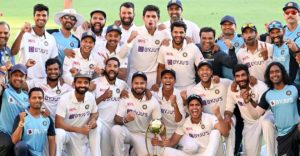 This victory would go down in the annals of history as the best series win by India on foreign soil mainly because of the lack of resources that they faced through out. India played 20 players through the 4 match series – the highest ever by any cricket team in a series and to come up trumps even after that just showed the exemplary spirit and fighting courage that the team possessed.
This victory would go down in the annals of history as the best series win by India on foreign soil mainly because of the lack of resources that they faced through out. India played 20 players through the 4 match series – the highest ever by any cricket team in a series and to come up trumps even after that just showed the exemplary spirit and fighting courage that the team possessed.
If there was a Rahane century, then there were Pujara’s stoic half-centuries. If there was the grace of Gill, then there were the sehwagesque Pant’s knocks. And above all, we had the debutants who all came out winners and did their part on the given occasion.
As India celebrates the 50th anniversary of our first overseas series victories in West Indies and England, it in a way was the best return gift to that generation who in a way started the evolution of the Indian cricket team.
As we return back to our daily lives, let’s not forget that we are living in strange times and the pandemic of Covid-19 is yet to leave us and to organise these tours amidst such difficulties in itself deserve a large round of applause.
To all around the world, A Pantastic new year, 2021!




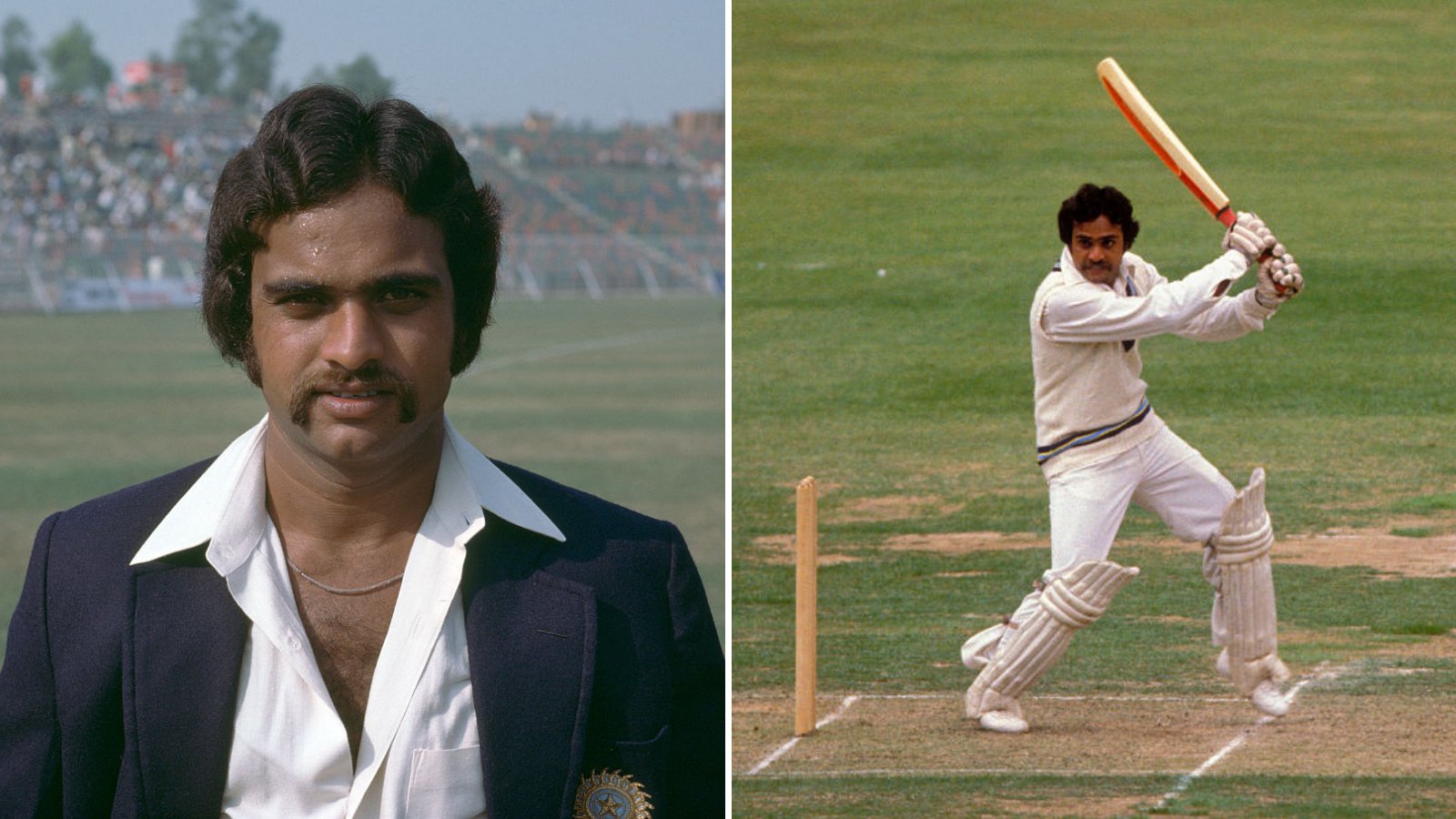



Good details provided of India Australia encounters. Cheers!
Thanks Devraj 🙂